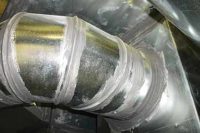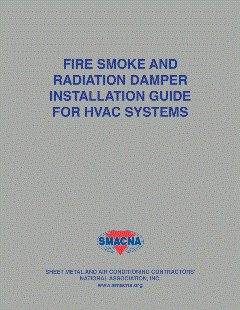Many HVAC professionals simply don’t see the value in making aspects of building science part of their daily operations. One idea that has helped a lot of HVAC professionals see this need is the “Building Side of the Duct System” concept. Let’s look at this a little bit more.
Building Comfort
When you examine most buildings, they can typically be broken down to simple structures made up of walls, a ceiling, and a floor. To keep these structures comfortable, insulation is added and attempts are made to keep unconditioned air out and in the places it is supposed to be. These structures are conditioned with HVAC systems, hopefully delivering the heating and cooling homeowners have paid for.
Have you ever considered the role of the building in relationship to a forced-air HVAC system? Think about this for a moment: What makes the connection between the airflow coming out of the supply registers and the airflow going back through the return grilles? If you said the building, you’re 100 percent correct. If you’re reading this article in a building that has a forced-air HVAC system in it, you’re sitting inside the duct system right now.
There are really two sides to the duct system. There is the traditional side of the duct system that applies directly to the HVAC system; this includes the ducts, dampers, insulation, air-handling equipment, sealants to prevent air leakage, registers, and grilles.
On the other side, you have the building side of the duct system. Just like the traditional side of the duct system, you have the ductwork, which consists of the rooms in the building. There is the insulation, which is found in the floors, walls, and ceilings (if you’re lucky). Then, there are the dampers, which consist of interior doors. This is a new way of looking at the homes and buildings you are in on a daily basis. Let this sink in a bit.
Controlling Air Leakage
Just as with a traditional HVAC duct system, in order to have a properly functioning system, you have to contain the air inside of the ducts. If you have excessive air leakage, the likelihood of comfort problems existing is pretty high.
The building side of the duct system is no different, with the exception of you living in it. There has to be some form of sealant in place to prevent joints in the building side of the duct system from leaking air.
The Too-Tight Myth
There are some common myths associated with building air leakage that are considered truth by many. These myths have hindered many HVAC professionals from making the proper decisions and hindered their ability to make good solutions available to their customers. They trust in these myths too much. The most common of these myth, is that a building needs to breathe. You can never have a building that is too tight, but you can under ventilate one.
Just as with a traditional duct system, in order to control the air, you have to contain the air in the duct system. A leaky building does not allow you this control. Instead, it allows Mother Nature control over the air movement. You need to use methods and ways of controlling air that overpower the influences of Mother Nature. When she controls the pressure differences in a home, bad things tend to happen.
The easiest way to provide this overpowering influence is through mechanical ventilation. This allows you to provide for the airflow requirements for those who are living in the building side of the duct system. It also allows you to counteract some of Mother Nature’s control to some extent.
The Insulation Tie-in
The insulation on a duct system is critical to ensuring the temperature leaving the HVAC equipment is within an acceptable limit once it reaches the building side of the duct system. If the ducts are located in an area that is subject to extreme temperatures like an attic or crawlspace, this insulation is vital to proper system operation and performance.
The insulation for the building side of the duct system plays an equally important role. If the installation of the insulation is poor, or the levels of insulation are inadequate, the building side of the duct system will lose and gain heat faster than the traditional side of the HVAC system can keep up with.
This often results in comfort complaints from a customer who may have a perfectly operating HVAC system. Yet, the insulation in the building side of the duct system is creating these issues. Unless you are looking at both sides of the duct system, you’ll miss opportunities to improve the duct system and leave your customers with a real comfort and efficiency problem.
Conditioned Space Manual Dampers
Dampers that are improperly adjusted in a traditional duct system can lead to comfort problems. Dampers in the building side of the duct system are no different in this type of interaction. Where dampers in the traditional duct system are made of metal and are adjusted by metal handles, dampers in the building side of the duct system are made of wood and called doors. They are adjusted constantly by your customers through the use of metal handles as well. They’re called door knobs.
When these dampers are adjusted by your customers, pressure imbalances can occur. This is likely to happen in systems that have a central return, or in those that have not been air balanced. If you don’t take this type of constant interaction into account, it can drive you crazy trying to diagnose that intermittent comfort complaint that only appears in the evening.
Door undercuts are recommended by many as a fix for this, but are often ineffective in providing the needed pressure relief for a room. Unless you can talk your customers into saloon-style doors, you might need to look at other options for solving issues related to the conditioned space manual dampers, like adding additional return ducts and grilles.
It’s Your Decision
The reality is many HVAC professionals are being blamed for various issues that might not be directly related to their HVAC systems. Yet, these issues have a significant impact on the comfort of your customers. These problems are often invisible, so you need processes in place to uncover them and determine which side of the duct system the real issue is on. Is the issue on the building side of the duct system? Is the issue on the traditional side of the duct system, or is it a combination of both? Unless you understand how to test and diagnose both sides of the duct system, you may never know.
Publication date: 6/9/2014
Want more HVAC industry news and information? Join The NEWS on Facebook, Twitter, and LinkedIn today!












